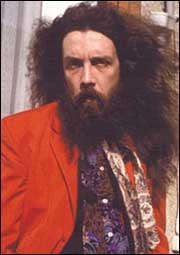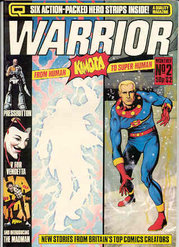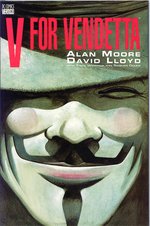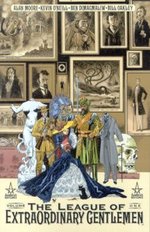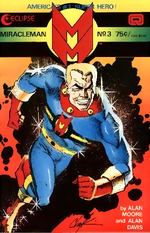Alan Moore
Alan Moore (born November 18, 1953, in Northampton, England) is a British writer most famous for his work in comics. He is the co-creator of some of the most acclaimed comic books in history, including Watchmen, V for Vendetta, From Hell and The League of Extraordinary Gentlemen. more...
Overview
Moore is renowned for bringing more mature, literary sensibilities to a medium often dismissed as juvenile and trivial. As well as including adult themes and challenging subjects, he also experiments with the form of comics, employing effects unique to the medium, and creating different ways to combine text and image. Many of his peers and critics consider him to be the finest writer working in the comics industry today. He brings a wide range of influences to his work, including Michael Moorcock and other authors of the New Wave of science fiction, horror writers like Clive Barker, more mainstream literary authors such as William S. Burroughs, Thomas Pynchon and Iain Sinclair, and film-editing techniques from the work of directors like Nicolas Roeg. Comics artist Bryan Talbot, whose The Adventures of Luther Arkwright anticipated the adult comics movement, is also undoubtedly a major influence.
Moore is also a practising magician, having become a gnostic in the mid-1990s, and part of a performance art group, the Moon and Serpent Grand Egyptian Theatre of Marvels. Two of their pieces, The Birth Caul and Snakes and Ladders, have been adapted for comics by Eddie Campbell. He has written a novel, Voice of the Fire, a set of short stories about linked events in his home-town of Northampton through the centuries, from the Bronze Age to the present day.
He has written one screenplay, the unmade Fashion Beast, a recreation of Beauty and the Beast commissioned by Malcolm McLaren. Two of his comics, From Hell and The League of Extraordinary Gentlemen, have been made into Hollywood movies, and the film Constantine was based upon the character John Constantine, which Moore created during his Swamp Thing run, but Moore has been disappointed by the adaptations and refused to accept any money for any future film adaptations of his work, donating it instead to the artists with whom he created the respective characters. Nonetheless, a film of V for Vendetta is in development, written by the Wachowski brothers and starring Natalie Portman. Again, Moore requested that his name not be associated with the film after seeing the script and calling it 'imbecilic'. After a press release falsely reported that Moore supported the film, Moore cut all of his ties with DC Comics, removing the last project he had with the company, The League of Extraordinary Gentlemen, from their lineup.
A tribute and in depth biography of Alan Moore in his Fiftieth Year entitled Alan Moore: Portrait of an Extraordinary Gentleman is currently available. All proceeds of this publication will go to charity.
Career
Early work
Moore began his career in the late 1970s as a cartoonist, drawing underground-style strips for music magazines like Sounds and the NME under the pseudonym Curt Vile, sometimes in collaboration with his friend Steve Moore (no relation), and a regular strip, Maxwell the Magic Cat, under the pseudonym Jill de Ray, for the Northants Post newspaper.
Deciding he could not make a living as an artist, he concentrated on writing, providing scripts for Marvel UK, 2000 AD and Warrior. At Marvel he wrote short strips for Doctor Who Magazine and Star Wars Weekly before beginning a celebrated run on Captain Britain with artist Alan Davis, running in a variety of Marvel UK publications. At 2000 AD he started by writing one-off Future Shocks and Time Twisters, moving on to series such as Skizz (E.T. as written by Alan Bleasdale, with Jim Baikie), D.R. and Quinch (a sci-fi take on National Lampoon's characters O.C. and Stiggs, with Davis) and The Ballad of Halo Jones (the first series in the comic to be based around a female character, with Ian Gibson). The last two proved amongst the most popular strips to appear in 2000 AD but Moore became increasingly concerned at his lack of creator's rights, and in 1986 stopped writing for 2000 AD, leaving the Halo Jones story incomplete.
Of his work during this period, it is the work he produced for Warrior that attracted greater critical acclaim; Marvelman (later retitled Miracleman for legal reasons), a radical re-imagining of a forgotten 1950s superhero drawn by Garry Leach and Alan Davis; V for Vendetta, a dystopian pulp adventure about a flamboyant anarchist terrorist who dresses as Guy Fawkes and fights a future fascist government, illustrated in stark chiaroscuro by David Lloyd; and The Bojeffries Saga, a comedy about a working-class English family of vampires and werewolves, drawn by Steve Parkhouse.
Warrior closed before these stories were completed, but other comic companies were quick to pick up and complete the stories.
The American mainstream
Moore's British work brought him to the attention of DC Comics editor Len Wein, who hired him in 1983 to write Swamp Thing, then a fairly formulaic monster comic, and also the poorest selling of DC's titles. Moore, along with artists Stephen R. Bissette, Rick Veitch and John Totleben, deconstructed and rebuilt the character from the ground up, writing a series of formally experimental stories that addressed environmental and social issues alongside the horror and fantasy.
Once it was clear that Moore had revitalised Swamp Thing and that he brought great critical acclaim, he was given more to write by DC.These included backup Green Arrow stories in Detective Comics, a two part story in Vigilante plus various Batman and Superman stories. The most acclaimed of this work was the final two part Superman story (Whatever Happened to the Man of Tomorrow?) before John Byrne's revamp in 1986 and of course, The Killing Joke with artist Brian Bolland.
Read more at Wikipedia.org

